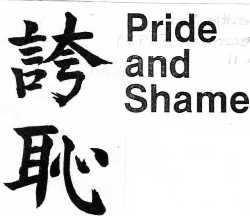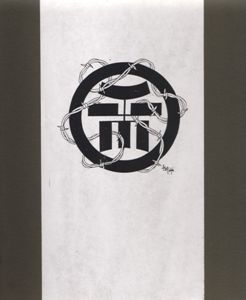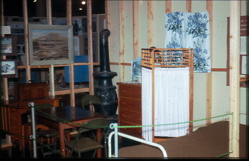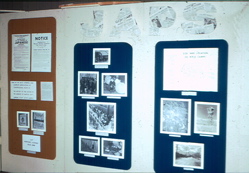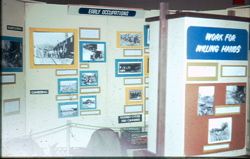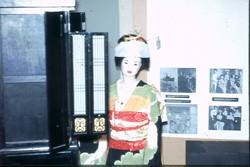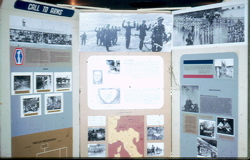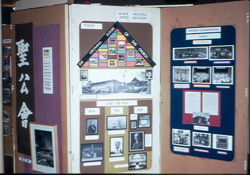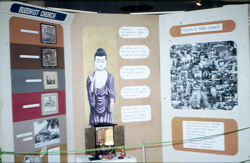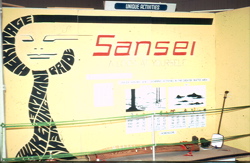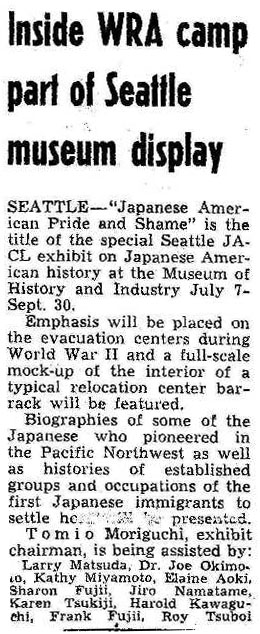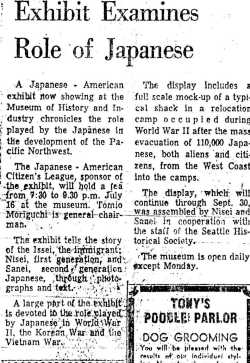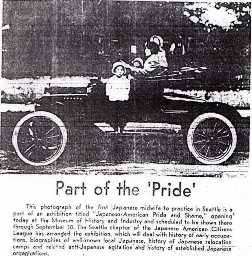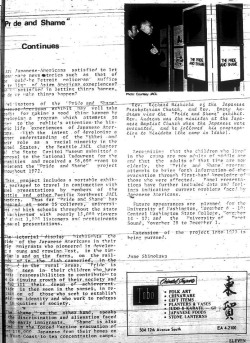In the summer of 1970, the Seattle chapter of the Japanese American Citizens League (JACL) organized a revolutionary museum exhibit and showcased it at Seattle’s Museum of History and Industry (MOHAI) for a three month period. The exhibit was titled “Pride and Shame,” and chronicled the history of the Japanese and Japanese Americans in the Pacific Northwest from the late 1800s to the present, 1970. Though museum staff expected the exhibit to be a community celebration, a significant part of the exhibit focused instead on the Japanese internment experience during World War Two. “Pride and Shame” helped the public and younger Japanese Americans learn what internment was like and witness the full extent of its effects after years of silence. The exhibit had lasting effects on those who saw it, and millions of others who did not see it. This essay tells the story of how “Pride and Shame” helped change public opinion about the Japanese American experience in World War Two. The exhibit was displayed at a pivotal time in American history, following on the heels of major gains by the civil rights movement. The resulting community into which “Pride and Shame” was showcased provided for a receptive and thoughtful reaction. By questioning internment, the exhibit prompted scholars and non-scholars alike to revisit the issue and take seriously the need for reparations. The ensuing Japanese American redress movement of the 1970s traces its roots to the “Pride and Shame” exhibit.
Investigating “Pride and Shame” was a complicated, yet fulfilling undertaking. Information about the museum exhibit is scant, difficult to interpret, and, at times, incomplete. The main points of reference about “Pride and Shame” come from two sets of papers at the University of Washington Libraries Special Collections: The Donald Kazama Papers and the Seattle JACL Papers. Wading through the stacks of artifacts, notes, and miscellaneous papers was tedious but informative and rewarding. Robert Shimabukuro’s book, Born in Seattle: The Campaign for American Redress, proved to be a valuable secondary source of information about Seattle’s Japanese community and its influential role in the movement for redress. Shimabukuro considers the “Pride and Shame” exhibit, and argues that it was a vital factor in getting Japanese Americans to seek political and economic redress for internment.
The Pride and Shame exhibit did not emerge out of thin air. It came out of years of pent up emotion in the Japanese American community. It came from a real event that affected thousands of Japanese and non-Japanese people in very different ways. Before the particulars of the exhibit are discussed, it is important to set up the need from which the exhibit originated and the context within which it was created.
History: The Japanese American Internment Experience
When Pearl Harbor was bombed by the Japanese on December 7, 1941, Japanese citizens and aliens within the United States were just as shocked as the non-Japanese. Many Japanese-Americans living in the United States were American citizens. The bombing was just as much an attack on Japanese living in the United States as it was on the general public. Even though those of Japanese descent were equally attacked in the bombing, they endured a much different fate than the general public. In the atmosphere of wartime hysteria, President Franklin Delano Roosevelt issued Executive Order 9066 on February 19, 1942. This presidential decree announced that those of Japanese descent presented a severe threat to the security of the United States. This threat was considered so great that the decision was made to relocate Japanese and Japanese Americans to the interior of the United States to internment camps. Despite protection of the writ of habeas corpus and the pursuit of life, liberty, and property under the Constitution, both of these safeguards were denied by the Executive Order 9066.1 Over 110,000 Japanese and Japanese Americans were uprooted from their homes along the West coast and forced to move into the interment camps. Because the Japanese were not given much notice about their evacuation, many lost their homes, businesses, and possessions. The Commission on Wartime Relocation and Internment of Civilians estimates that the total property lost was $1.3 billion, and net income lost was $2.7 billion (calculated in 1983 dollars).2 More damaging to the Japanese community was the loss of personal liberty and dignity.
Ten interment camps were established in remote areas of the United States. They included: Heart Mountain in Wyoming, Tule Lake and Manzanar in California, Topaz in Utah, Poston and Gila River in Arizona, Granada in Colorado, Minidoka in Idaho, and Jerome and Rowher in Arkansas.3 These places were to house Japanese and Japanese Americans for more than four years, but they never were to become home. Families were crammed into small barracks, surrounded by barbed-wire fences and armed guard towers.
The internment camps were cleared of their prisoners in early 1945 and many Japanese and Japanese Americans returned to their homes. Unfortunately, there was not much to return to; the Japanese communities that had once thrived in the United States had been destroyed by four years in internment camps. They set to work to regain what had been lost during internment, but the path to success and acceptance was rough for all and unattainable for some. The distrust and betrayal of the United States had a lasting effect on the Japanese community. Feelings of shame, resentment, sadness, and confusion plagued many Japanese and Japanese Americans. These feelings were dealt with in varying ways: Some people tried to forget what had happened to them, many lived in shame and bitterness, and some even thought that internment had been for their best and perhaps was deserved. As Larry Matsuda, an educator and activist born in Minidoka internment camp, recently pondered:
What can you do if the government—your government—turns against you? You are a citizen and they put you in jail overnight and you are then an outlaw. Would you want to talk about that afterwards? No, it’s something you want to forget, move on past.4
And yet, not everyone was willing to forget and move on from their internment experience. Some Japanese Americans fought for acknowledgment and justice for what had happened to the Japanese in the United States.
Although over 110,000 people had been removed from their homes, many among the general public were unaware of the extent to which the Japanese and Japanese American suffered during World War Two. The ignorance and prejudice of most Americans regarding the internment insulted and alarmed those who were victimized by it. Furthermore, many of the younger Japanese Americans were not fully aware of what their elders had endured. The desire to inform these two unknowledgeable groups coincided with a growing but understated desire to seek retribution from the government for the injustices inflicted upon the Japanese. As that need became more strongly felt in the Japanese American community, it was clear that awareness about the internment experience would have to be raised among the public. The Asian youth movement of the late 1960s was part of this awareness raising.5 So was the national campaign, from 1967 to 1971, to repeal Title II of the McCarran Act on the grounds that it could be used to rationalize another round of internment of American “subversives.”6 In Seattle, the first major attempt to revisit the issue of Japanese internment occurred in the summer of 1970 through the creation of the “Pride and Shame” exhibit.
Planning for Story-Telling: Creating a Museum Exhibit
The planning and implementation of “Pride and Shame” resulted from the Japanese American Citizens League (JACL) efforts in Seattle. This national civil rights group had been created in 1929 in California to promote Japanese Americans’ rights, taking its inspiration in part from the Seattle Progressive Citizens League.7 After World War Two, the group actively sought aid from the government for ”resettlement” after internment, a form of redress. Although these efforts were met with some action by the government, it was not considered adequate by JACL activists.
In early 1970, Seattle’s Museum of History and Industry (MOHAI) asked the Seattle JACL to put together an exhibit to coincide with the 1970 Expo in Osaka.8 MOHAI asked that the exhibit display the history of Japanese Americans in the Pacific Northwest, with a focus on the JACL. The JACL accepted the offer, but ended up bringing a different agenda to the exhibit than MOHAI had expected.
Tomio Moriguchi, owner of Seattle’s prominent Uwajimaya grocery store, was the President of the Seattle JACL chapter at the time. He helped turn the exhibit space provided to the JACL by MOHAI into an opportunity to do more than display cultural aspects of the Japanese and Japanese Americans in the Northwest. When he created and co-chaired the JACL’s exhibit Committee, he inadvertently put together a Committee that included community activists who wanted to put particular emphasis on the incarceration of the Japanese during World War Two. Minoru Masuda co-chaired the Committee with Moriguchi, and Committee members included Harold Kawaguchi, Donald Kazama, Larry Matsuda, James Morishima, Elaine Nakai, June Shimokawa, Calvin Tokagi, Ben Yorito, Barbara Yoshida, and Fran Wada.9
Quickly, then, the MOHAI exhibit expanded to incorporate booths from community groups throughout the city, and shifted its focus to include political as well as social topics. Initial support for the shift was gauged by a letter dated April 3, 1970, in which the Seattle JACL described the possible museum exhibit and called for support from within the Japanese community. “The topic for consideration will be Japanese culture, art and history as it relates to the third generation citizens…Your comments and ideas as well as assistance will be needed to make a worthy display.”10 Japanese organizations that responded and aided in the creation of the exhibit included multiple Japanese churches; the Nisei Veteran’s Committee; the Japanese Consulate General of Seattle; Asian Coalition for Equality (ACE); the Japanese Cultural Festival, Inc.; the Rokka Ski Club; and Boy Scout Troop #53.11 Moriguchi described the positive response as an event taking place at a fitting moment. “Maybe the timing was right. It gave people an opportunity to release some pent-up emotions, feelings that were bottled up.”12 With a budget of $600, such backing was essential.13 The JACL received support from these organizations through the donation of photographs, personal testimonies, help in organizing the display, and advertisement of the exhibit. Work on the exhibit brought people of various organizations and of widely varying ages together to work towards a common goal for the first time. This overwhelming show of support and fraternity encouraged all involved, and allowed the JACL to move along in the planning stages excitedly.
Less than one month later, on May 1, 1970, the JACL sent out invitations for the exhibit.14 The invitation provided the exhibit’s specifics and informed readers about its objective. The invitation said the exhibit’s purpose was “To show the general public, and particularly the younger Japanese people, the history to date of the Japanese people in the United States.” The invitation further described the exhibit’s purpose as displaying “the history of the Japanese relocation camps and anti-Japanese agitation, biographies of well-known local Japanese, the history of established Japanese organizations, and the history of early Japanese occupations.” 15 While the invitation described the educational goals of the exhibit, the Seattle JACL hoped that much more would be learned from the display. In an informational book about the exhibit, the JACL wrote, “this public program is submitted with the hope that it will bring unity to a divided society, understanding of the nature of diversity in a pluralistic culture, and the recognition of the dignity of all groups.”16 Approaching the presentation of the exhibit with high expectations for public revelation and approval, the JACL continued to collect archives and refine the exhibit layout.
What’s In A Name?
An important aspect to the exhibit was the creation of a strong and compelling title. Larry Matsuda, the first teacher to introduce Asian American history into Washington State’s schools, and the youngest member of the Pride and Shame Committee, came up with the name “Pride and Shame” at one of the Committee meetings. Taken from a Walter Cronkite special called “The Nisei: The Pride and the Shame,” Matsuda adapted it to “Pride and Shame.” He went on to explain to the committee members the suitability of the title, relating the pride in the achievements of the Japanese Americans and the shame from the injustice of being interned.17 A report written after the exhibit was shown described the two opposing words of the title:
‘Pride’ refers to the proudness and spirit of an immigrant race who came to these alien shores to seek its fortunes. ‘Pride’ refers to their accomplishments as pioneers in a young and growing west…‘Pride’ means their families and their children, the second generation Nisei, marginal, trying to bridge the gap with one foot in the Japanese community and the other in an unfriendly, dominant society, striving to fulfill the dreams of achievement. ‘Pride’ means the Sansei, the third generation, seeking to establish their identity, working to redress the inequities of society in their own different way.18
To complete the Japanese American story, however, it was essential to include and acknowledge the shame of being discriminated against, interned, and betrayed by the American government. The report further described:
‘Shame’ means the history of prejudice and discrimination that white society has long inflicted on minorities…’shame’ means the explosion of fear, hysteria, and racism that resulted in the forced wartime evacuation of over 110,000 Japanese, two thirds of them American citizens, from their homes on the west coast to 10 concentration camps in the interior. As the Nikkei people now seek to eradicate inequities that exist in all fields of endeavor for all minorities, it is the ‘shame’ of American society that such inequities exist.’19
The title “Pride and Shame” reflected approximately 100 years of Japanese history in the United States, supporting the exhibit’s wide range of topics. The committee accepted the title for the exhibit and continued advertising the exhibit.
The Exhibit
The subjects for the exhibit were given much consideration by the JACL committee and Japanese American contributors. After deliberating on multiple topics and methods of presentation, the committee decided on seven issues within the Japanese American community’s past and present: the Issei Pioneer, The Japanese American Community, World War Two and Evacuation, Concentration Camps—USA, Proof In Blood, Sansei Looks at Today, and The Challenge. Included within the framework of these overarching themes were details of early occupations of the Japanese, Japanese American organizations and activities, well-known, local Japanese American personalities, and the Japanese American World War Two experience. These subjects were displayed through the use of photographic essays, scale models, and cultural objects along multiple panels.20 The style in which the subjects were displayed created a mood of sharing—and rightfully so, since the goal of the exhibit was to share the Japanese American experience with younger members of the community and the general public.
The internment experience did not dominate the exhibit, even if it is what the Pride and Shame would be most remembered for. The pride of the Japanese for their community, heritage, and perseverance was well documented in the exhibit. Numerous pictures featured Japanese from different eras engaging in cultural and American activities. A female mannequin displayed the traditional dress of a Japanese woman, while pictures on the panel behind her showed Japanese men and women in American attire. Other panels showed the various Japanese religious institutions. The Buddhist Church received three panels and exhibited pictures of the church, a picture collage of Japanese youth, and information about Buddhism. Another three panels were dedicated to the Blaine Memorial United Methodist and the Japanese Congregational Church. Photographs were the main medium used to convey information, showing people, the church structures, and portraits of various pastors. Multiple panels chronicled the early occupations of Japanese settlers through pictures, including railroading, lumbering, fisheries and canneries, farming, and hotel work. A scale model on display portrayed Japanese men working on the construction of railroad tracks. Finally, several panels spoke to the Sansei, the third generation of Japanese in the United States, describing current events and activities within the community.21 All of these subjects highlighted the positive history of the present situation of the Japanese American community and individuals. The accomplishments of the Japanese Americans on display depicted and kindled pride within the community. The inclusion of these positive aspects of the Japanese American experience was vital to the exhibit. Because the “Pride and Shame” exhibit was the first of its kind to display the injustices inflicted upon the Japanese Americans during World War Two, it was sure to meet unreceptive and unwilling audiences. The pleasant feelings evoked from the “pride” displays would be beneficial to viewers when observing those parts of the exhibit dedicated to the “shame” of America’s wartime policies.
Three panels were dedicated to the incarceration experience of the Japanese and Japanese Americans; the title was made of newspaper headlines and spelled out “JAPS.” One panel presented the notices and public proclamations of the Japanese evacuation. It also showed examples of yellow peril propaganda. In bold letters and in the middle of this panel, a quote from Supreme Court Justice Murphy describing the injustice of internment was placed: “One of the most sweeping and complete deprivations of constitutional rights in the history of this nation in the absence of martial law.” One of the fears about displaying the internment history was a revival of Japanese discrimination.22 This quote reminded viewers that what had happened was indeed an injustice. A second panel showed pictures of the evacuation process. The photographs displayed groups of Japanese leaving their homes, boarding trains to the internment camps, waiting with luggage, and other images of relocation. Other pictures portrayed the barracks and the camps, highlighting the desolate and inadequate living conditions in which the Japanese were forced to subsist. The third panel in the series showed more images of camp life. A map of the United States illustrated where the ten internment camps were located, and an aerial shot of one camp provided viewers with an idea of the camp structure. A picture of a guard tower reminded viewers that the Japanese had not been relocated into normal housing conditions, but rather to heavily secured barracks. The photo of a lonely, dusty, and ugly street displayed a typical camp scene.23 These panels displayed the shame that the Japanese community felt towards their experience and also showed the shame of the government for forcing the evacuation of thousands of innocent people. The internment experience was further depicted through a full-scale model of the interior of a barrack. The set showed the cramped living quarters and the lack of privacy that a barrack provided. Included in the model were a twin bed, a table and three chairs, a dresser, a desk, and a wood-burning stove. The “room” appeared clean and attempted a homey atmosphere, but was obviously extremely small and inappropriate for a family. This life-size model gave many viewers their first glimpse at the living conditions in which Japanese lived during World War Two. These panels and displays depicting “shame” evoked various emotions and responses from the viewers. Unfortunately, not all of the reactions were sensitive to the Japanese experience.
Reactions to “Pride and Shame”
The director of MOHAI, Sutton Gustison, had been on vacation when the exhibit was set up. When she returned, she was disturbed by parts of the exhibit—namely the displays and panels about Japanese internment. 24 Mrs. Gustison had thought that the exhibit would showcase harmless Japanese cultural items and practices, such as traditional clothing and art. Moriguchi explained: “I guess she didn’t like history that wasn’t kind.”25 The exhibit caught Mrs. Gustison so off guard that she attempted to have the questionable parts removed.26 Her efforts were unsuccessful, however, and the public saw the display as it was intended to be viewed.
The exhibit was on display from July 7 to September 7, 1970.27 In all, some 34,000 people, Japanese and non-Japanese alike, saw the “Pride and Shame” exhibit at MOHAI. The JACL and MOHAI sent out invitations and flyers to the Japanese American community as well as many others. Flyers and pamphlets were also created and distributed.28 The public also became informed of the exhibit through media coverage, albeit scant. Both The Seattle Times and The Seattle Post-Intelligencer ran a brief notice about the exhibit in the Arts and Entertainment section around the exhibit’s opening in early July. The Times featured a photograph from the exhibit of several Japanese people in a car, titled “Part of the Pride.”29 A short blurb about the exhibit provided readers with the essentials, but did not offer a review of the exhibit. The P-I provided a somewhat longer article than the Times, but not much more in the way of opinion. Titled, “Exhibit Examines Role of Japanese,” the article mostly described for readers what the exhibit featured.30 The Pacific Citizen, the national JACL publication, wrote only a short article titled “Inside WRA camp part of Seattle museum display.”31 Although targeted to Japanese Americans, the newspaper did not significantly highlight the profound museum exhibit or relate its importance to its readers. Given the large number of people who viewed the “Pride and Shame” exhibit, it is surprising that so little attention was paid to it by the media.
Many of those who viewed the “Pride and Shame” were of Japanese descent. It is hard to know how the Japanese American community as a whole felt about the exhibit. Many had spoken openly about internment while others had long been silent, and reactions to the exhibit likely varied. An interview with Matsuda in November 2005 provides some insight into the complicated reactions of Japanese Americans to internment. On the one hand, Matsuda noted that his parents spoke openly about internment, and actually participated in reunions with people they met while interned. But on the other hand, Matsuda noted, “Japanese are not like Italians…there’s a lot of keeping it inside, not expressing things…you don’t say anything, you don’t complain, you don’t make waves.”32 Even though we don’t know the exact feelings of those who saw the exhibit, we know that “Pride and Shame” got people thinking.
In a JACL report following the MOHAI exhibit, Moriguchi wrote that the “products of the exhibit were: (1) youth involvement, (2) interest from other communities in the display, and (3) a general awakening of the Japanese people to their history and activities.”33 The exhibit caused enough Japanese Americans to evaluate their feelings towards their internment experience that the redress movement gained significant support and publicity. Furthermore, “Pride and Shame” was considered so important by its creators and many who viewed it that the exhibit was turned into a traveling display that eventually toured the Pacific Northwest.
“Pride and Shame” on the Road
While “Pride and Shame” may not have attracted the attention of the media, it did get the attention of several other museums and Japanese communities in other parts of the Northwest. Kenneth Hopkins, director of the Washington State Capitol Museum asked Tomio Moriguchi if he would be interested in creating a “joint museum-community project” out of “Pride and Shame.”34 Moriguchi and the Seattle JACL decided to continue the “Pride and Shame” project and take the display on the road. Moriguchi turned things over to Dr. Minoru Masuda, a professor of psychiatry at the University of Washington and co-Chair of the Pride and Shame Committee, because of his knowledge of attaining grants.35 In mid-October, Minoru sent a hefty report to the National Endowment for the Humanities in request of a grant totaling $8571.00, to be used from July 1st 1971 to December 31st 1973.36 The application provided a brief history of the Japanese American community and emphasized the need to tell the story of internment to more people. The application further explained the breakdown of the traveling exhibit, listing how it would travel, where to, and what would be included in the exhibit. The grant application was reviewed and in late March 1971 earned the JACL just over $6500.00 to put “Pride and Shame” on the road.37
A new committee was created within the JACL to take on the many tasks of changing the original exhibit into a traveling one. “It was changed quite a bit,” Moriguchi recalled.38 Much of the same material and information was included in the traveling exhibit, but showcased in a new way. Members worked to revise the display; they built new pieces and structures and designed the panels to be easily put up and taken down. Furthermore, the committee decided to enhance the exhibit with a live presentation by knowledgeable people. Described as “ a verbal, hard-hitting aspect to the exhibit…calculated to make a dynamic [impact],”39 the panel was considered to be a vital addition to the exhibit. Not only would the pictures and displays speak to viewers, but members of the Japanese community would share stories, lead discussions, and answer questions.
Like the naming of the original exhibit, the quest for the exhibit logo produced an informative, artistic, and crucial graphic design. Frank Fujii designed what is still used and known today as “the call to arms.” The logo depicts the character representation of the Issei, Nisei, and Sansei generations surrounded by a circle, and ringed with barbed wire.40 This logo accompanied all advertising and followed the exhibit wherever it went, symbolizing the collaboration of the three Japanese American generations on the project. With the logistics of the exhibit worked out, the committee set to finding places to showcase the exhibit.
In the grant application, Minoru wrote, “It is felt that this exhibition must be seen by as many people as possible. It is not designed to be shown only in educational institutions, but should be placed in shopping center malls, civic centers, public buildings and community centers…and military reservations.”41 Despite these lofty goals of expansive showcasing, the exhibit was primarily displayed in community colleges, high schools, and museums.42The State Capitol Museum in Olympia featured the exhibit first in early January 1972. The traveling “Pride and Shame” also made appearances at Shoreline, Highline, Tacoma, Big Bend, Columbia Basin and Spokane Falls community colleges. It was also viewed at Bainbridge, Franklin, Sammamish and Mercer Island high schools. The Seattle JACL and Japanese American communities throughout the Pacific Northwest felt that the “Pride and Shame” exhibit was so important that they applied for and were granted an extension of funding for additional years of travel. This extension allowed even more people to view the Japanese American history and culture. The last showing of the exhibit was in 1975 at Western Washington University. Despite the exhibit’s extensive travels, turnout was not as high as expected. Moriguchi and the Pride and Shame organizers had hoped to make a huge splash in the region and the nation. He reflected that
We just thought thousands of people would have to come to see our exhibit. But there wasn’t that much interest … in retrospect, I don’t think we made as much impact as I thought we would or could or should have…I think that if I were to do it now, we would promote it much differently, bigger…43
Moriguchi saw the exhibit’s impact as most concentrated on the nation’s Japanese American community instead of the country as a whole. That said, over 100,000 people had seen the exhibit by the time it was packed up in 1975.
Towards Redress
The traveling exhibit was largely successful. Once again, however, media attention was scarce, and few reactions to the exhibit were recorded. Why was there so little reporting on the “Pride and the Shame” exhibit? It is difficult to determine all of the factors that went into the reception of the exhibit by the public and the media. The fact that there is little information about the “Pride and Shame” exhibit and its response by the public does not leave us empty-handed. Rather, the lack of information is in itself information. Perhaps the public was not prepared to openly acknowledge a crime committed against some of its inhabitants under the watch of everyone. Another factor that played into how the exhibit was received was the relative novelty at the time of a political museum exhibit that questioned the American government’s handling of World War II. Especially at MOHAI, exhibits mostly displayed “pretty” history and cultural artifacts. For example, exhibits showcased at MOHAI between its founding in 1952 and “Pride and Shame” include: “Christmas Around the World,” “Boeing History,” “Early Day Outdoors,” and “Towboating.” 44 The lack of provocative exhibits provided for a mismatched atmosphere in which “Pride and Shame” entered. As one of the first museum displays to feature injustices at MOHAI, “Pride and Shame” might have taken some by surprise.
Although media coverage is rapid and has far-reaching powers, there are other benchmarks from which we can measure the success of “Pride and Shame.” One such point of reference is literature. From scholarly articles to personal testimonies, literature concerning the Japanese internment began to be published in huge numbers. A search through various databases proves that before 1970, the year in which “Pride and Shame” was exhibited, journalism about Japanese internment was scarce. According the University of Washington Libraries Database, a total of about 19 books about Japanese internment was published between 1940 and 1969.45 The search returned ten books published from 1940 to 1949, six books from 1950 to 1959, and three books from 1960 to 1969. The growing demand for redress during the 1970s and 80s was met with the publication of countless books, articles, and journals, as well as the production of videos and sound recordings. The new texts focused more specifically on the injustice of the internment experience, effects of internment on the Japanese American population, and the need for reparations. From 1970 to 1980, 19 books were published, and from 1980 to 1990, 43 books about internment were published. A search of the OCLC WorldCat database, an international literature search engine, reports that 54 books hit the shelves between 1980 and 1990, while 20 sound recordings were created.46 The titles sported by the new literature spoke of the changing attitude among Japanese Americans and the public. No longer were titles simple and nice; instead, many of the titles aggressively called out to readers. Behind Barbed Wire, In Search of Justice, Concentration Camps USA, and Personal Justice Denied are just a few examples of the hard-hitting and compelling titles displayed on literature after 1970.
The “Pride and Shame” exhibit played an important part in this rise in interest in the Japanese American World War Two experience. The exhibit successfully reached over 100,000 people and acted as a turning point for many who viewed it. It presented internment in the voice of Japanese Americans, and indicated that they were ready for action to seek redress. The exhibit was also seen by non-Japanese. The revelation to whites and other groups about what had happened to the Japanese created an audience more receptive to the campaign for redress. The exhibit created a yearning for more knowledge about Japanese internment among some. Others felt the need to share their story or opinions to reach even more people.
“Pride and Shame” is credited with having provided an important spark to the movement for redress in the Japanese American community. In Born in Seattle, author Shimabukuro reports that within the traveling dates of “Pride and Shame” the initial plans for redress were presented by Henry Miyatake at a Seattle JACL meeting.47 The issue had a galvanizing effect in Seattle, and a ripple effect throughout the nation.
Despite increased action towards redress and publicity about Japanese internment, justice was a long time coming. Not until 18 years after the showcasing of “Pride and Shame” did the Japanese American community receive a belated apology. On August 10, 1988, President Reagan signed the Civil Liberties Act into law. This act awarded those interned a “national apology and monetary compensation to the surviving Japanese Americans” affected by internment. 48 Each interned person was to receive a check for $20,000 from the federal government as restitution for their suffering and property losses. These reparations paid to thousands of surviving individuals would not have been possible without the determination and hard work of the Seattle JACL, including one of its first attempts at “Pride and Shame.”
As reported in Born in Seattle, the Seattle JACL pushed the national JACL to take up the issue. Seattle Representative Mike Lowry introduced the first redress legislation to the U.S. House on November 28, 1979. As Lowry later noted, “If you had to say what’s the one reason of the redress legislation passing, it was because of the Seattle Chapter JACL.”49 The “Pride and Shame” exhibit appeared to have subtle effects, but they were far-reaching and powerful on levels from personal suffering to national history.
In today’s fast-paced, high-tech world, information and education about internment is readily available and commonly known. This has not always been the case, however. Not until after the “Pride and Shame” exhibit in 1970 did literature about Japanese relocation and internment become widely available. The increasing production of internment and redress concerned literature reflected the growing support and publicity of the redress movement. Because of “Pride and Shame” a community that had repressed its feelings and its history was better able to talk about their experiences and emotions. Because of “Pride and Shame” many people unfamiliar with the injustice imposed upon the Japanese became informed. Because of “Pride and Shame” a community finally became outraged at what had been done to them and fought for redress. Because of “Pride and Shame” the priceless histories of an aging population were captured before they were lost forever.
Copyright © Allison Shephard 2006
HSTAA 498 Autumn 2005
1Executive Order 9066: The Internment of 110,000 Japanese Americans, Asian American Studies Center,
University of California, Los Angles. http://www.sscnet.ucla.edu/aasc/ex9066.
2 Executive Order 9066: Resulting in the Relocation of Japanese (1942),
http://www.ourdocuments.gov/doc.php?flash=false&doc=74#.
3 Executive Order 9066: Resulting in the Relocation of Japanese (1942).
4 Larry Matsuda, interview by Trevor Griffey and Allison Shephard, November 3, 2005, Seattle Civil
Rights and Labor History.
5 Steve Louie and Glenn K. Omatsu, eds. Asian Americans : The Movement and the Moment. Los Angeles, Calif.: UCLA Asian American Studies Center Press, 2001.
6 Masumi Izumi. “Prohibiting ‘American Concentration Camps’: Repeal of the Emergency Detention
Act and the Public Historical Memory of the Japanese American Internment.” Pacific Historical Review, Vol. 74, No. 2, pages 165–193
7 The Seattle Chapter, Japanese American Citizens League, Seattle Chapter, http://www.jaclseattle.org/.
8 Donald D Kazama, Papers, University of Washington Special Collections. Accession # 1356, 1794, 2012-7, Box 13, “Japanese American Citizen League: Youth Activity Report – June 16 thru Sept. 1970.”
9 JACL Seattle Chapter. Papers. University of Washington Special Collections. Accession # 217-6, 919, 919-4, 1814, 1820, Box 10, “Pride and Shame: Informational Background to the Pride and Shame Exhibit.”
10 Kazama, Papers, Letter sent out on 3 April 1970.
11 JACL Seattle Chapter. Papers. University of Washington Special Collections. Accession # 217-6, 919, 919-4, 1814, 1820, Box 10.
12 Robert S. Shimabukuro, Born in Seattle: The Campaign for Japanese American Redress. Seattle: University of Washington Press, 2001, pg. 6.
13 Kazama, Papers: JACL Youth Activity Report - June 16 thru Sept. 1970.
14 JACL Seattle Chapter, Papers, Invitation, 1 May, 1970.
15 JACL Seattle Chapter, Papers, Invitation, 1 May, 1970.
16 JACL Seattle Chapter, Papers, “Pride and Shame: Informational Background to the Pride and Shame Exhibit.”
17 Larry Matsuda, interview by Trevor Griffey and Allison Shephard, November 3, 2005, Seattle Civil Rights and Labor History Project. matsuda.htm
18 JACL Seattle Chapter, “Pride and Shame: Informational Background to the Pride and Shame Exhibit.”
19 JACL Seattle Chapter, “Pride and Shame: Informational Background to the Pride and Shame Exhibit.”
20 JACL Seattle Chapter, Papers, “Display of Japanese American History.”
21 Museum of History and Industry, Slides, “Japanese American.”
22 Frank Abe, “Pride and Shame: Japanese Americans and the 38-Year Journey to Justice.” The Seattle Sun, 5 December, 1979. P.11.
23 Museum of History and Industry, Slides.
24 Elizabeth Furlow, “Japanese American Pride and Shame Exhibit at Museum of History and Industry,” Information sheet, MOHAI, September 25, 2000.
25 Shimabukuro, Born in Seattle, p. 6.
26 Tomio Moriguchi, interview by Becky Fukuda, December 9, 1999. Segment 7. Densho Visual History Interview. www.densho.org
27 http://www.historylink.org/essays/output.cfm?file_id=3635
28 Kazama, Papers, “The Pride and The Shame” pamphlet.
29 The Seattle Times, “Part of the ‘Pride,’” 12 July, 1970, C1.
30 The Seattle Post-Intelligencer, “Exhibit Examines Role of Japanese,” 12 July, 1970, W9.
31 Pacific Citizen, “Inside WRA camp part of Seattle museum display,” 26 June, 1970.
32 Larry Matsuda, interview by Trevor Griffey and Allison Shephard, November 3, 2005, Seattle Civil Rights and Labor History Project. matsuda.htm
33 Kazama, Papers, JACL Youth Activity Report-June 16 thru Sept. 1970.
34 Shimabukuro, Born in Seattle, p. 10.; Tomio Moriguchi. Interview by Becky Fukuda, December 9, 1999, Segment 8. Densho Visual History Interview. www.densho.org
35 Shimabukuro, Born in Seattle, p. 10.
36 JACL Seattle Chapter Papers, Project Grant Application.
37 Shimabukuro, Born in Seattle, p. 10.
38 Tomio Moriguchi. Interview by Becky Fukuda, December 9, 1999, Segment 8. Densho Visual History Interview. www.densho.org
39 JACL Seattle Chapter. Papers, Pride and Shame Traveling Exhibit and Program.
40 Shimabukuro, Born in Seattle, p. 11.
41 JACL Seattle Chapter, Papers, Project Grant Application.
42 JACL Seattle Chapter, Papers, Possible Itinerary-Pride and Shame.
43 Tomio Moriguchi. Interview by Becky Fukuda, December 9, 1999, Segment 8. Densho Visual History Interview. www.densho.org
44 Museum of History and Industy, “Chronology of MOHAI Exhibits.”
45 University of Washington Libraries,http://www.lib.washington.edu. Advanced keyword searches Japanese Americans and internment, Japanese Americans.
46 University of Washington Libraries, OCLC WorldCat,http://www.lib.washington.edu/types/databases/o.html. Advanced keyword searches: Japanese Americans and internment.
47 Shimabukuro, Born in Seattle, p. 17.
48 Leslie T. Hatamiya, Righting a Wrong: Japanese Americans and the Passage of the Civil Liberties Act of 1988. Stanford: Stanford University Press, 1993. P.
49 Shimabukuro, Born in Seattle, p. 111.

